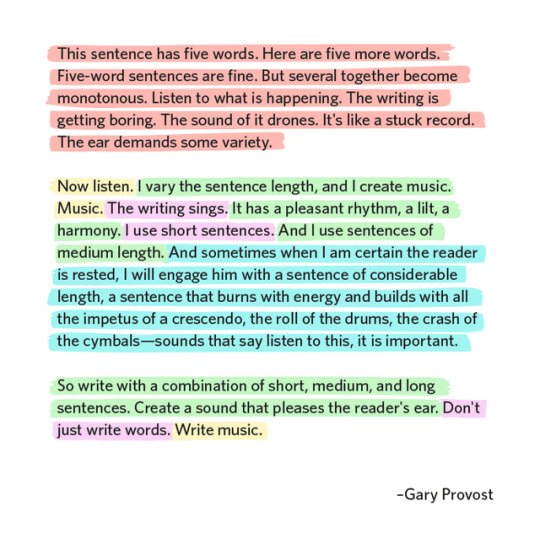Text
oh youre bi? why dont you "bi" me some time with a distraction while i crack this safe ya fuckin goon
157K notes
·
View notes
Text
i do enjoy "living weapon" characters but specifically living weapons who did in fact do absolutely horrific things which at least a part of them enjoyed and thought was good and right at the time, and that no amount of not knowing any better or guilt they feel in hindsight will ever make up for. i love living weapons who are "irredeemable", and no it's not their fault that they were made that way or pointed in the directions they were by the hand that wielded them, and yes they are victims, but so were their victims. living weapons who some people will never be able to forgive, but who still wake up every day and try to do better than what's expected of them. a sword that uses its blade to cut wheat to make bread for the people who once lived in fear of its arc falling on their heads.
42K notes
·
View notes
Text
guys i need you to be less comfortable making super negative comments abt a character in the tags of a random post abt that character. like i support haterism but make your own post. please stop and think about whether op, a person who is interested in this character enough to make posts abt them, wants to hear all that. i see this too much from people reblogging from me and it makes me embarrassed that you’re reblogging from me. you are being rude
34K notes
·
View notes
Text
fucking sucks ass that detective is a subtype of cop or always some type of law enforcement. a detective should be someone who is a master of disguise, a weirdo, socially maligned, and hated by the police. he should solve the cases using his ultra specific knowledge about geography, linguistics, human biology, and cigar ashes
39K notes
·
View notes
Text
top five most important things you can give a character. 1. bisexuality. 2. autism. 3. so much negative rizz it loops around into irresistibility. 4. so many bad events. 5. a coping mechanism that’s cute and silly provided you don’t think about it too hard
78K notes
·
View notes
Text
One of my major pet peeves with Jekyll & Hyde adaptations is that they always give Hyde the Hulk-treatment by turning him into this large, monstrous creature when in the book he actually becomes smaller and younger after his transformation?! No, for real, he SHRINKS. And he's not exactly monstrous or ugly; his vibes are just rotten. People tend to describe an encounter with him as "I cannot put my finger on it but something was just OFF about this guy." Vibe check failed. Imagine this mellow, middle-aged, dad-bod gentleman suddenly turning into a nasty frat boy who just automatically evokes a flight-or-fight response in you. Like, you just take one look and instinctively go "Ew, he looks like a terrifying asshole, I want to deck him in the face." That's Edward Hyde.
1K notes
·
View notes
Text
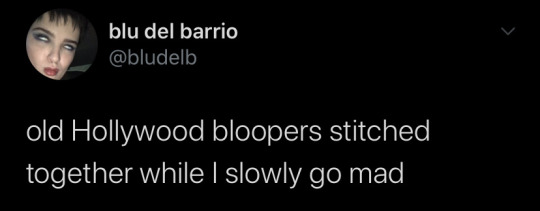
I love this so much, I’m gonna start saying “nuts” we need to bring it back
468K notes
·
View notes
Text

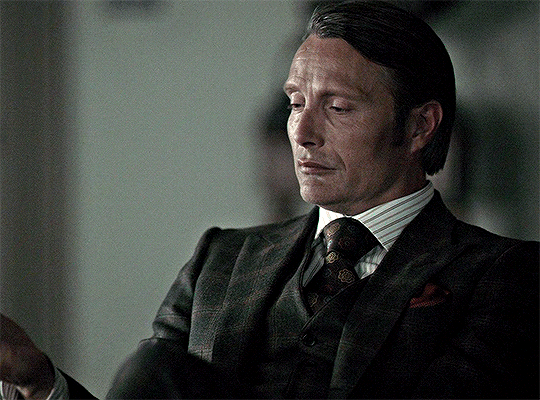
i really loved this moment where hannibal flips a coin about whether to save bella's life or not, it perfectly shows how little human life matters to him. he's not even curious what would happen if he saved her, he's curious what would happen if he flipped the coin
729 notes
·
View notes
Text
Words for Skin Tone | How to Describe Skin Color
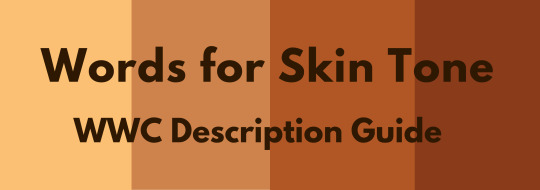
We discussed the issues describing People of Color by means of food in Part I of this guide, which brought rise to even more questions, mostly along the lines of “So, if food’s not an option, what can I use?” Well, I was just getting to that!
This final portion focuses on describing skin tone, with photo and passage examples provided throughout. I hope to cover everything from the use of straight-forward description to the more creatively-inclined, keeping in mind the questions we’ve received on this topic.
Standard Description
Basic Colors

Pictured above: Black, Brown, Beige, White, Pink.
“She had brown skin.”
This is a perfectly fine description that, while not providing the most detail, works well and will never become cliché.
Describing characters’ skin as simply brown or beige works on its own, though it’s not particularly telling just from the range in brown alone.
Complex Colors
These are more rarely used words that actually “mean” their color. Some of these have multiple meanings, so you’ll want to look into those to determine what other associations a word might have.

Pictured above: Umber, Sepia, Ochre, Russet, Terra-cotta, Gold, Tawny, Taupe, Khaki, Fawn.
Complex colors work well alone, though often pair well with a basic color in regards to narrowing down shade/tone.
For example: Golden brown, russet brown, tawny beige…
As some of these are on the “rare” side, sliding in a definition of the word within the sentence itself may help readers who are unfamiliar with the term visualize the color without seeking a dictionary.
“He was tall and slim, his skin a russet, reddish-brown.”
Comparisons to familiar colors or visuals are also helpful:
“His skin was an ochre color, much like the mellow-brown light that bathed the forest.”
Modifiers
Modifiers, often adjectives, make partial changes to a word.The following words are descriptors in reference to skin tone.
Dark - Deep - Rich - Cool
Warm - Medium - Tan
Fair - Light - Pale
Rich Black, Dark brown, Warm beige, Pale pink…
If you’re looking to get more specific than “brown,” modifiers narrow down shade further.
Keep in mind that these modifiers are not exactly colors.
As an already brown-skinned person, I get tan from a lot of sun and resultingly become a darker, deeper brown. I turn a pale, more yellow-brown in the winter.
While best used in combination with a color, I suppose words like “tan” “fair” and “light” do work alone; just note that tan is less likely to be taken for “naturally tan” and much more likely a tanned White person.
Calling someone “dark” as description on its own is offensive to some and also ambiguous. (See: Describing Skin as Dark)
Undertones
Undertones are the colors beneath the skin, seeing as skin isn’t just one even color but has more subdued tones within the dominating palette.
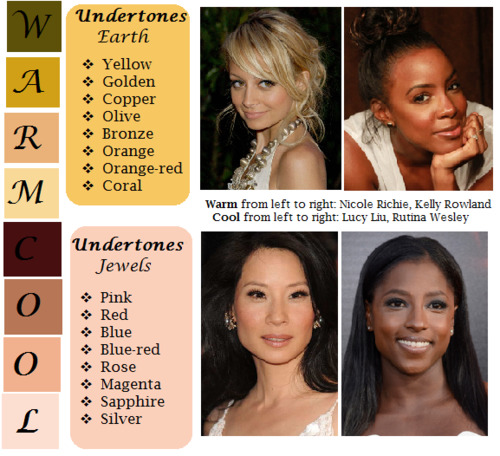
pictured above: warm / earth undertones: yellow, golden, copper, olive, bronze, orange, orange-red, coral | cool / jewel undertones: pink, red, blue, blue-red, rose, magenta, sapphire, silver.
Mentioning the undertones within a character’s skin is an even more precise way to denote skin tone.
As shown, there’s a difference between say, brown skin with warm orange-red undertones (Kelly Rowland) and brown skin with cool, jewel undertones (Rutina Wesley).
“A dazzling smile revealed the bronze glow at her cheeks.”
“He always looked as if he’d ran a mile, a constant tinge of pink under his tawny skin.”
Standard Description Passage
“Farah’s skin, always fawn, had burned and freckled under the summer’s sun. Even at the cusp of autumn, an uneven tan clung to her skin like burrs. So unlike the smooth, red-brown ochre of her mother, which the sun had richened to a blessing.”
-From my story “Where Summer Ends” featured in Strange Little Girls
Here the state of skin also gives insight on character.
Note my use of “fawn” in regards to multiple meaning and association. While fawn is a color, it’s also a small, timid deer, which describes this very traumatized character of mine perfectly.
Though I use standard descriptions of skin tone more in my writing, at the same time I’m no stranger to creative descriptions, and do enjoy the occasional artsy detail of a character.
Creative Description
Whether compared to night-cast rivers or day’s first light…I actually enjoy seeing Characters of Colors dressed in artful detail.
I’ve read loads of descriptions in my day of white characters and their “smooth rose-tinged ivory skin”, while the PoC, if there, are reduced to something from a candy bowl or a Starbucks drink, so to actually read of PoC described in lavish detail can be somewhat of a treat.
Still, be mindful when you get creative with your character descriptions. Too many frills can become purple-prose-like, so do what feels right for your writing when and where.
Not every character or scene warrants a creative description, either. Especially if they’re not even a secondary character.
Using a combination of color descriptions from standard to creative is probably a better method than straight creative. But again, do what’s good for your tale.
Natural Settings - Sky
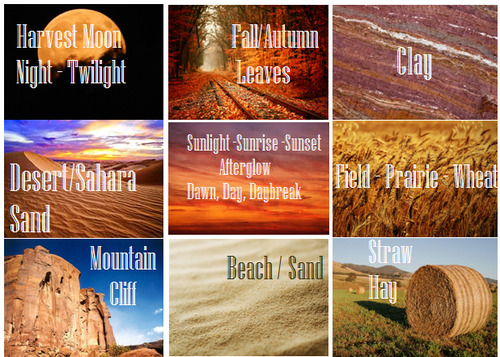
Pictured above: Harvest Moon -Twilight, Fall/Autumn Leaves, Clay, Desert/Sahara, Sunlight - Sunrise - Sunset - Afterglow - Dawn- Day- Daybreak, Field - Prairie - Wheat, Mountain/Cliff, Beach/Sand/Straw/Hay.
Now before you run off to compare your heroine’s skin to the harvest moon or a cliff side, think about the associations to your words.
When I think cliff, I think of jagged, perilous, rough. I hear sand and picture grainy, yet smooth. Calm. mellow.
So consider your character and what you see fit to compare them to.
Also consider whose perspective you’re describing them from. Someone describing a person they revere or admire may have a more pleasant, loftier description than someone who can’t stand the person.
“Her face was like the fire-gold glow of dawn, lifting my gaze, drawing me in.”
“She had a sandy complexion, smooth and tawny.”
Even creative descriptions tend to draw help from your standard words.
Flowers
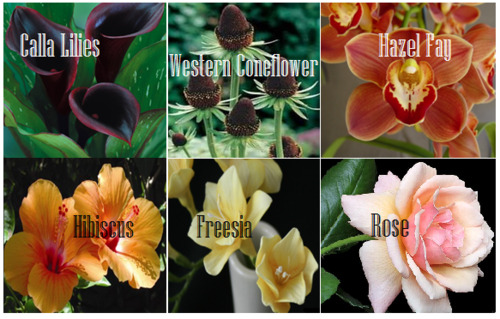
Pictured above: Calla lilies, Western Coneflower, Hazel Fay, Hibiscus, Freesia, Rose
It was a bit difficult to find flowers to my liking that didn’t have a 20 character name or wasn’t called something like “chocolate silk” so these are the finalists.
You’ll definitely want to avoid purple-prose here.
Also be aware of flowers that most might’ve never heard of. Roses are easy, as most know the look and coloring(s) of this plant. But Western coneflowers? Calla lilies? Maybe not so much.
“He entered the cottage in a huff, cheeks a blushing brown like the flowers Nana planted right under my window. Hazel Fay she called them, was it?”
Assorted Plants & Nature

Pictured above: Cattails, Seashell, Driftwood, Pinecone, Acorn, Amber
These ones are kinda odd. Perhaps because I’ve never seen these in comparison to skin tone, With the exception of amber.
At least they’re common enough that most may have an idea what you’re talking about at the mention of “pinecone."
I suggest reading out your sentences aloud to get a better feel of how it’ll sounds.
"Auburn hair swept past pointed ears, set around a face like an acorn both in shape and shade.”
I pictured some tree-dwelling being or person from a fantasy world in this example, which makes the comparison more appropriate.
I don’t suggest using a comparison just “cuz you can” but actually being thoughtful about what you’re comparing your character to and how it applies to your character and/or setting.
Wood

Pictured above: Mahogany, Walnut, Chestnut, Golden Oak, Ash
Wood can be an iffy description for skin tone. Not only due to several of them having “foody” terminology within their names, but again, associations.
Some people would prefer not to compare/be compared to wood at all, so get opinions, try it aloud, and make sure it’s appropriate to the character if you do use it.
“The old warlock’s skin was a deep shade of mahogany, his stare serious and firm as it held mine.”
Metals

Pictured above: Platinum, Copper, Brass, Gold, Bronze
Copper skin, brass-colored skin, golden skin…
I’ve even heard variations of these used before by comparison to an object of the same properties/coloring, such as penny for copper.
These also work well with modifiers.
“The dress of fine white silks popped against the deep bronze of her skin.”
Gemstones - Minerals
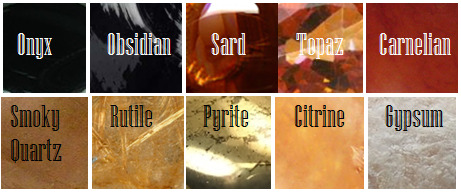
Pictured above: Onyx, Obsidian, Sard, Topaz, Carnelian, Smoky Quartz, Rutile, Pyrite, Citrine, Gypsum
These are trickier to use. As with some complex colors, the writer will have to get us to understand what most of these look like.
If you use these, or any more rare description, consider if it actually “fits” the book or scene.
Even if you’re able to get us to picture what “rutile” looks like, why are you using this description as opposed to something else? Have that answer for yourself.
“His skin reminded her of the topaz ring her father wore at his finger, a gleaming stone of brown, mellow facades.”
Physical Description
Physical character description can be more than skin tone.
Show us hair, eyes, noses, mouth, hands…body posture, body shape, skin texture… though not necessarily all of those nor at once.
Describing features also helps indicate race, especially if your character has some traits common within the race they are, such as afro hair to a Black character.
How comprehensive you decide to get is up to you. I wouldn’t overdo it and get specific to every mole and birthmark. Noting defining characteristics is good, though, like slightly spaced front teeth, curls that stay flopping in their face, hands freckled with sunspots…
General Tips
Indicate Race Early: I suggest indicators of race be made at the earliest convenience within the writing, with more hints threaded throughout here and there.
Get Creative On Your Own: Obviously, I couldn’t cover every proper color or comparison in which has been “approved” to use for your characters’ skin color, so it’s up to you to use discretion when seeking other ways and shades to describe skin tone.
Skin Color May Not Be Enough: Describing skin tone isn’t always enough to indicate someone’s ethnicity. As timeless cases with readers equating brown to “dark white” or something, more indicators of race may be needed.
Describe White characters and PoC Alike: You should describe the race and/or skin tone of your white characters just as you do your Characters of Color. If you don’t, you risk implying that White is the default human being and PoC are the “Other”).
PSA: Don’t use “Colored.” Based on some asks we’ve received using this word, I’d like to say that unless you or your character is a racist grandmama from the 1960s, do not call People of Color “colored” please.
Not Sure Where to Start? You really can’t go wrong using basic colors for your skin descriptions. It’s actually what many people prefer and works best for most writing. Personally, I tend to describe my characters using a combo of basic colors + modifiers, with mentions of undertones at times. I do like to veer into more creative descriptions on occasion.
Want some alternatives to “skin” or “skin color”? Try: Appearance, blend, blush, cast, coloring, complexion, flush, glow, hue, overtone, palette, pigmentation, rinse, shade, sheen, spectrum, tinge, tint, tone, undertone, value, wash.
Skin Tone Resources
List of Color Names
The Color Thesaurus
Skin Undertone & Color Matching
Tips and Words on Describing Skin
Photos: Undertones Described (Modifiers included)
Online Thesaurus (try colors, such as “red” & “brown”)
Don’t Call me Pastries: Creative Skin Tones w/ pics I
Writing & Description Guides
WWC Featured Description Posts
WWC Guide: Words to Describe Hair
Writing with Color: Description & Skin Color Tags
7 Offensive Mistakes Well-intentioned Writers Make
I tried to be as comprehensive as possible with this guide, but if you have a question regarding describing skin color that hasn’t been answered within part I or II of this guide, or have more questions after reading this post, feel free to ask!
~ Mod Colette
168K notes
·
View notes
Text
Signs that you might be an ancient immortal with dementia:
- flashes of memory that you think are deja vu or something that your parents or others have forgotten (it’s probably a memory from centuries ago resurfacing)
- feeling like you’ve forgotten something every time you leave the house even though you absolutely got everything (you *have* forgotten something, but that was a long time ago. check the local museum, you might find something familiar)
- tired. so very, very tired. you don’t know why, and you don’t think you’re depressed. (you’ve literally exhausted all your mental strength since you’ve been around for so long)
there’s more, but i’m actually too tired to think about it. also, i think i might’ve forgotten some points, but idk, can’t remember, haha.
553 notes
·
View notes
Text
one thing i never get tired of in songs is when they include some sounds from the recording booth like a laugh at the end, a��‘was that good?’ or like, the sounds of the guitar being put down, a chair creaking. it’s nice how music can be used as an escape but also something that ties you right back down to earth. it will affect you so deeply & then ur like wow… you just played that. it’s grounding & magical & just one of my fave things ever!
158K notes
·
View notes
Text
devotion that corrupts is my favorite btw there's nothing wrong with it ever & it should be encouraged
74K notes
·
View notes
Text
what people think is hard about writing: describing the joy, love, beauty, grief, loss and hope that form the richness of human experience
what is actually hard about writing: describing basic actions such as turning, leaning over, reclining, gesturing, saying something in a quiet voice, breathing, getting up from chairs, and walking across rooms
148K notes
·
View notes
Text
Villain X Hero concept
The hero seduces the villain very slowly and subtly over the course of many encounters. Then, when the villain is at their most vulnerable, the hero captures them.
The hero is expecting the villain to laugh and congratulate the hero on their clever plan. Or maybe to be furious, to kick and scream and swear vengeance. Or maybe even to have seen this coming, to have an escape plan already in motion.
But all the villain does is stare at the hero with sad, confused eyes. Quietly, they ask, "So none of it was real, then?"
The hero shifts their weight, crossing their arms. They scoff. "If course not. Did you forget, I'm the hero. You're the villain. I could never love you."
Silence. Then, very slowly, the villain shakes their head. The confusion has slipped from their expression, leaving only forlorn despondence.
"I'm suppose to be the villainous one, but that, that was truly evil."
1K notes
·
View notes
Text
Screw love at first sight give me annoyances at first sight give me my OTP locking eyes and deciding that yes annoying this person brings me great joy and I shall do it till I die
Bastards to lovers who still tease each other trope
2K notes
·
View notes

